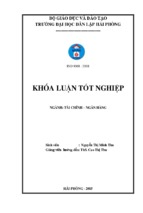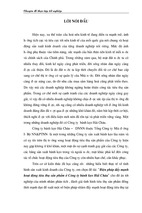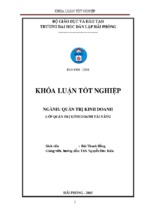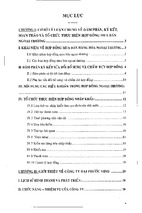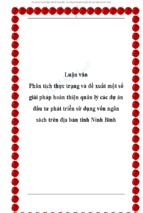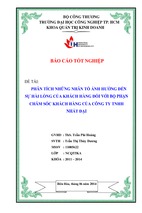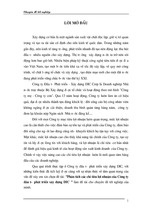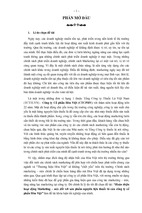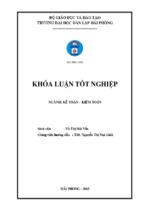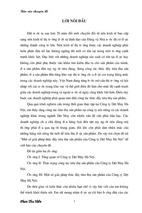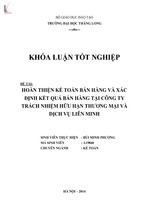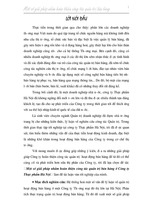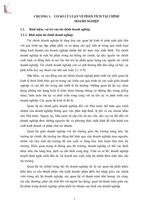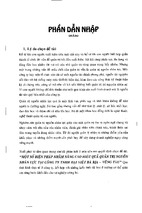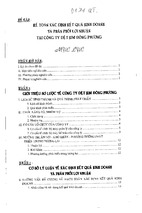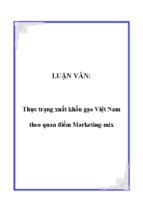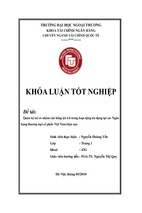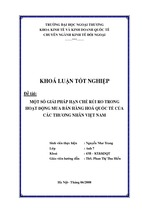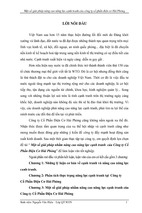MINISTRY OF EDUCATION AND TRAINING
VINH UNIVERSITY
ĐẶNG THỊ HẢI LÝ
CHALLENGES FACED BY INFORMATION
TECHNOLOGY STUDENTS IN READING
ENGLISH FOR COMPUTER SCIENCE
(NHỮNG THÁCH THỨC SINH VIÊN CÔNG NGHỆ
THÔNG TIN GẶP PHẢI TRONG KỸ NĂNG ĐỌC MÔN
TIẾNG ANH CHUYÊN NGÀNH KHOA HỌC MÁY TÍNH)
Master Thesis in Education
Field: Theory and Methodology
of English Language Teaching
Code: 60.14.10
Vinh, 2011
1
TABLE OF CONTENTS
CHAPTER I: INTRODUCTION.................................................................................3
I.1. Rationale.................................................................................................................3
I.2. Aims and objectives:..............................................................................................4
I.3. Method of the study...............................................................................................4
I.4. Scope of the study:.................................................................................................5
I.5. Significance of the study........................................................................................5
I.6. Organization of the study:......................................................................................6
1.7. Summary................................................................................................................6
CHAPTER II: LITERATURE REVIEW.....................................................................7
II.1. The nature of reading............................................................................................7
II.1.1. Reading:.............................................................................................................7
II.1.2. Reading comprehension....................................................................................9
II.1.3. Reading process:..............................................................................................10
II.1.3.1. Bottom-up models of the reading process:...................................................11
II.1.3.2. The top-down models of the reading process:.............................................12
II.1.3.3. The interactive models of the reading process:...........................................14
II.1.3.4. Schema Theory.............................................................................................16
II.1.4. Classification of reading..................................................................................17
II.1.4.1. Classification of reading according to manner of reading..........................17
II.1.4.2. Classification of reading according to purpose of reading.........................18
II.2. Reading in General English (GE) and in ESP....................................................20
II.2.1. ESP reading.....................................................................................................21
II.2.1.1. Definition of ESP..........................................................................................21
II.2.1.2. Reading comprehension in ESP...................................................................22
II.2.1.3. Types of ESP................................................................................................23
II.2.1.4. Characteristics of ESP.................................................................................24
II.2.2. Challenges in ESP Reading.............................................................................25
II.2.2.1. Language challenges....................................................................................25
II.2.2.2. Reading skill challenges...............................................................................26
II.2.2.3. Methodology and Materials.........................................................................27
II.2.3. Differences between ESP and EGP................................................................29
II.2.4. The ESP learners.............................................................................................30
II.2.5. Learners’ learning strategies...........................................................................31
II.2.6. Learner-centeredness in ESP and Learning-Centeredness............................32
II.2.7. The requirements for ESP teachers.................................................................33
II.3. Summary.............................................................................................................34
CHAPTER III. RESEARCH METHODOLOGY...................................................35
III.1. The setting of the study.....................................................................................35
III.1.1. The purposes of teaching and learning reading English for Computer
Science at Nghe An Junior Teacher Training College...............................................35
III.1.2. Teachers of English at Nghe An JTTC and their methods of teaching........36
III.1.3. IT Students at Nghe An JTTC and their background knowledge..................37
III.1.4. Materials.........................................................................................................38
2
III.2. The participants.................................................................................................39
III.3. Research method................................................................................................39
III.3.1. Research questions:........................................................................................39
III.3.2. Data collection instruments......................................................................40
III.3.3. Data collection procedure..............................................................................40
III.3.4. Data analysis procedure................................................................................41
III.4. Summary............................................................................................................41
CHAPTER IV.: FINDINGS AND DISCUSSION.....................................................42
IV.1. Sources of reading English for computer science challenges experienced by
second-year IT students at Nghe An JTTC................................................................42
IV.1.1. The participants’ background.........................................................................42
IV.1.2. Students’ attitudes towards ESP reading........................................................44
IV.1.3. Students’ perception of ESP reading challenges............................................47
IV.1.3.1. In the area of vocabulary.............................................................................47
IV.1.3.2. In the area of grammar................................................................................49
IV.1.3.3. In the areas of reading skills........................................................................51
IV.1.3.4. In the areas of discourse..............................................................................52
IV.1.4. The causes of challenges.................................................................................54
IV.1.4.1. The reading materials..................................................................................55
IV.1.4.2. The teachers.................................................................................................56
IV.1.4.3. The learners.................................................................................................56
IV.1.5. Students’ techniques to deal with new vocabularies and terminologies.......57
IV.1.6. The learners’ expectation for ESP reading materials...................................58
IV.1.7.The learners’ expectations in term of methodology.........................................60
IV.2. Discussion.........................................................................................................63
IV.3. Summary............................................................................................................63
CHAPTER V: CONCLUSION..................................................................................64
V.1. Summary of the main findings...........................................................................64
V.2. Conclusions.........................................................................................................65
V.3. Implications for the study...................................................................................66
V.3.1. Increasing students’ reading interest and motivation......................................66
V.3.3.Training students to become efficient readers..................................................68
V.3.4. Training students with different reading strategies.........................................68
V.3.5. Encouraging students to develop extensive reading habits.............................72
V.3.6. Giving homework and checking the previous lessons frequently....................73
V.3.7. Improving teachers’ background knowledge about Computer Science and
teaching methodology.................................................................................................74
V.3.7.1. Improving teachers’ background knowledge about Computer Science......74
V.3.7.2. Improving teachers’ teaching methodology..................................................74
V.3.8. Developing IT reading materials...................................................................75
V.3.8.1. Adapting and improving reading exercises...................................................75
V.3.8.2. Choosing appropriate supplementary reading materials.............................76
V.4. Limitations and Suggestions for further study...................................................77
REFERENCES...........................................................................................................78
3
CHAPTER I: INTRODUCTION
I.1. Rationale
I have been teaching at Nghe An Junior Teacher Training College (JTTC)
for ten years. English is taught with the purpose that the students will use it
effectively to fulfill their daily work in the future, so it receives great deal of
concern from both teachers and students here. Enormous attempts have been made
to provide the students with general English as well as English for Specific
Purposes (ESP). Now I find out that reading comprehension plays a very important
role in learning English as a foreign language, especially English for computer
science in Vietnam.
The main goal of ESP course, especially English for Computer Science is
aimed at providing the students with linguistic knowledge relevant to their field and
skills up to their expectation of their future employment. However, students
learning ESP in Vietnam rarely have opportunities to use English in communication
outside the classroom. They mainly have access to popular documents written in
English through reading. Hence, skills in reading English texts are naturally of
special importance in teaching and learning ESP, which is not an exception for the
ESP teaching at Nghe An JTTC. Nghe An JTTC is one of those where ESP involves
within an English teaching situation in response to the demand for specific language
skills for the specialists – the graduated doctors. Therefore, improving students’
reading skills is recognized as a principal objective of ESP course provided by
teachers of English at Nghe An JTTC.
Of the four skills, reading comprehension has always received a great deal of
attention. It is completely right because English is taught and learnt in other
countries, not the native countries. So reading comprehension is not only the
importance to get a new language but also for further study.
“ For many students, reading is by far the most important of the four
skills in a second language, particularly in English as a second or foreign
language” (Carrel, 1981:1). As we know, if students read well, they are able to
4
handle subjects related written materials in English and to work with modern
technological equipment.
In fact, many researchers find out that teachers are disappointed with
students’ reading comprehension. There are many challenges that we have to pay
attention to: Teaching methods, classroom techniques, unsuitable materials,
teachers and students’ attitude about the subjects.
For all these reasons, it is necessary to discover the areas of students’
reading challenges at Nghe An JTTC and the causes of their unsuccessful reading
comprehension. Problems have been found out. The researcher should do something
as suggestions to improve the learning for students about reading comprehension
of English for Computer Science at Nghe An JTTC.
I.2. Aims and objectives:
This study aims to examine the areas of challenges in reading comprehension
of English for Computer Science for second-year students in the department of
information technology at Nghe An JTTC. To be more specific, the objectives of
this study are:
-
To investigate the situation of teaching and learning English for Computer
Science in order to find out the students’ challenges in reading the materials
and causes of them.
-
To suggest the ways to overcome the challenges and help students to improve
their reading comprehension.
-
It is hoped that the findings from this study will be of some benefits to the
second-year students of information technology (IT) at Nghe An JTTC.
I.3. Method of the study
In order to achieve the aims mentioned above, the methodologies adopted for
this study are a survey questionnaire with 65 students which is used as the main
method to collect the needed data from the learners .
5
When carrying out this thesis, the author prepares a questionnaire to investigate
the second-year IT students’ challenges in learning reading English for Computer
Science and find out some possible causes of these challenges.
The questionnaire consists of 11 questions, based on the information in the
literature review part and the aims of the study. This questionnaire is prepared in
Vietnamese for the learners to read, think and answer suitably and adequately. After
that it is delivered to second-year IT students, and the answers are collected and
analyzed. The real challenges in learning reading English for Computer Science and
some possible causes to these difficulties will be found out.
I.4. Scope of the study:
It is too broad to deal with reading challenges of all types. Therefore, the
focus of this study is to investigate some problems in linguistics and reading skills
which are faced by second-year students of IT at Nghe An JTTC. Then, the
researcher will recommend some techniques to overcome reading challenges.
I.5. Significance of the study.
Reading is one of the four language skills which is very important in learning
a foreign language. Reading
will help students get adequate knowledge of
vocabularies, structures or ideas to speak and to write. Teaching the language itself
is the most typical use of reading in a foreign language class.
Despite the awareness of the importance of reading in ESP learning, some
students had a negative attitude towards ESP reading, which made their reading
more difficult.
What is more, when poor reading results are reported, one tends to blame the
students for having poor ability or for making insufficient effort. Nevertheless, the
students are not always at fault. There are other important factors in the process of
teaching and learning reading such as unsuitable teaching materials, teachers’
inappropriate teaching methods and classroom techniques. How to help them reach
the goal of reading comprehension is a great challenge. Hopefully, this study will
6
much help teachers of English at my college to better their teaching, motivate my IT
students to better their learning especially to improve their reading comprehension.
I.6. Organization of the study:
This major thesis consists of five chapters. Chapter 1 concludes the
rationale for the study, the aims, the methods, and the scope of the study as well as
the organization of the thesis.
Chapter 2 deals with the literature review. It discusses the theoretical background
to the nature of reading and reading comprehension and reading in ESP teaching
and learning. Chapter 3, the methodology chapter, will make it clear how the
present study was implemented, including information about context, participants ,
and procedures, instrumentation and data collection. Methods of analysis will be
addressed in Chapter 4. It investigates the current situation of teaching and learning
English for Computer Science at Nghe An JTTC. Analysis of a range of data
collected from various sources for the study will be clarified in this chapter. It
includes some discussion of findings and recommendations. Chapter 5 Conclusion - summarizes the main findings of the study, points out the limitations
and makes some suggestions for further research.
1.7. Summary
This chapter introduces the study. This introduction includes the rationale,
research methods, and the scope of of the study. Next chapter reviews the literature
for the study.
7
CHAPTER II: LITERATURE REVIEW
This chapter aims at providing a theoretical background to the study. The
review of the issues most relevant to be the focus of the study will be included:
definition of reading and reading comprehension, classification of reading
according to the purposes of reading; reading in ESP teaching and learning such as
definitions such as definition of ESP, types of ESP and challenges in teaching and
learning English for Computer Science; finally the typical features of IT texts will
also be discussed.
II.1. The nature of reading
II.1.1. Reading
Up to now, there are so many definitions of reading by perspectives-linguists,
psychologists, educators and second language researchers. When reading, we
understand the texts. We analyze and find its meaning give out meaningful
conclusion. But no one can define exactly what reading is. The question “What is
reading?” attracts much attention and reasearchers have defined reading in various
ideas. Each author has each different way to define.
Goodman(1971; 135) considers reading as “ a psycholinguistic process by
which the reader, a language user, reconstructs, as best as he can, a message which
has been encoded by a writer as a graphic display”.
William (1984) had the same view on reading, especially on the act of
reconstructions as Goodman. He argues that “ written texts, then often contain
more than we need to understand them. The efficient reader makes use of this to
take what he needs, and no more to obtain meaning” (p.3). His opinion is shared by
Nuttall and Grellet.
However, Hafner and July (1982:4) did not think that understanding is
known what the writer implied although they also mentioned the understanding
between the author and the readers. According to their opinion, “ reading involves
the identification and recognition of printed and written symbols which serve as
8
stimuli for the recall of meanings built up through past experiences and further
construction of new meanings through the readers’ manipulation of relevant
concepts already in his possession.”
Frank Smith (1985; 102) defined “ reading is understanding the author’s
thought”. It means that the readers “ read the author’s mind not the author’s
words”. He also added “ understanding print or even receiving communication can
hardly be said to explain reading ”. We know that the nature of reading is the
interaction between readers and the authors.
Harmer (1989: 153) considers reading as a mechanical process that “eyes
receive the message and the brain then has to work out the significance of the
message.” Harmer points out a view that reading activity consists of two actions
dominated by the eyes and the brain.
Rumelhart (1977) writes “ reading involves the reader, the text, and the
interaction between the reader and the text”. He emphasizes the important role of
both readers and reading texts.
According to Carell Devine and Eskey (1988:13) “ reading is a process in
that it starts with linguistic surface representation encoded by a writer and ends
with meaning, which reader constructs. There is, thus, an essential interaction
between language and thought in reading. The writer encodes thought in language
and the reader decodes language to thought ”. They mean that we can see clearly
the interrelationship between the writer, the reader and the text.
One more definition of reading is offered by Allen and Vallete (1977). They
thought that “ reading is developmental process” (p.249). We learn reading not only
to know how to read, to master the symbols, the language, the grammar, etc…used
in the text but also to understand the ideas, the information expressed in that text or
to develop the ability reconstructing its contents in our own words.
From all the opinions above, it is clear that no definition can possibly capture all
the ideas and features of what reading is. Each scholar’s definition reflects what
reading means as seen from his own point of view. However, they all try to find out
9
the nature of reading, that is “ understanding ” in which they emphasize on reading
process, reading message and readers. Nowadays, with the explosion of
information, reading has become more important.
II.1.2. Reading comprehension
In teaching and learning reading, reading comprehension plays a very
important role. Reading comprehension can be understood as the ability to attract
the required information from the text as efficiently as possible. There are three
elements involving in the reading process: the text being read, the background
knowledge of the reader, and the contextual aspects relevant for interpreting the
text.
Abbott (1981:82) gives out a research on the nature of reading
comprehension. According to him “ there are two broad aspects or levels. Firstly,
there is basically visual task that of deciphering the marks on the page, the brain
receiving signals from the eyes. Secondly, there is cognitive task that of interpreting
the visual information, so one is not simply barking at point.”
According to Swan ( 1975: 1 ) “ a student is good at comprehension ” if “
he can read accurately and efficiently, so as to get the maximum information of a
text with the minimum understanding”. , This means that the student can show his
understanding by re-expressing the content of the text in many ways such as
summarizing the text answering questions etc.
Grellet (1981:3) considered “ reading comprehension or understand a
written text means extracting the required information from it as effectively as
possible”.
Richard and Thomas (1987:9) describe reading comprehension as “an
understanding between the author and the reader.” The nature of reading
comprehension has been emphasized by these authors. It means that the readers
look at the printed words and try to understand the implied meanings of the author
basing on their background knowledge. This is a process whereby the printed words
inspire the ideas, experiences that are relevant to each individual.
10
Expressing the nature of reading comprehension, Grilled (1981:3) said that “
reading comprehension or understanding written text means axtracting the required
information from it as effectively as possible”. He means that the student can show
his understanding by re-expressing the content of the text in many ways such as
summarizing the text, answering questions etc.
Though these ideas are not exactly the same, they all seem that “ reading
without comprehension is meaningless”. ( Karlin and Kartin, 1982:2).
It is known that reading is usually clearly, completely, and permanently on
the page in front of us. Reading comprehension work should normally deal with
direct comprehension in silent reading. In other words, it should aim to develop the
skills competent readers use in their first language.
In conclusion, reading for comprehension is the primary purpose for reading;
raising students’awareness of main ideas in a text and exploring the organization of
a text are essential for good comprehension. We know that reading is much more
than just pronouncing words correctly or simply knowing what the authors intends.
It is known as a process in which the readers can recognize the graphic form and
understand the relation between the writing and the meaning. Thus, after reading,
students can find the way to bettering their grammar, words, pronunciation and can
understand the content of the text. Therefore, we comfirm that it is important for us
to understand what reading comprehension is. In order to help teachers who teach
reading find out the students’ difficulties of learning reading, they have to get a
profound understanding about the nature of reading comprehension.
II.1.3. Reading process
In this section, three models are going to be mentioned. They are bottom-up
models, top-down models and interactive models. Finally, schema theory models of
the reading process is expressed.
11
II.1.3.1. Bottom-up models of the reading process
We know that the reader begins with the written text (the bottom), and
constructs meaning from letters, words, phrases and sentences found within and
then processes the text in a linear fashion in bottom-up reading models. It seems to
be that bottom-up models analyze reading as a process in which small chunks of
texts are absorbed, analyzed and gradually added to the text chunk until they
become meaningful. It can be seen the passive role of the reader in the process as
these models are text driven ones of comprehension and the printed pages play an
important role. Samuels and Kamil (188:301) say: “ an important shortcoming of
these models is lack of feedback, in that no mechanism is provided to allow for
processing stages which occurs later in the system to influence processing which
occurs earlier in the system. Because of the lack of feedback loops in the early
bottom-up models, it was difficult to account for sentence-context effects and the
role of prior knowledge of text topic as facilitating variables in word recognition
and comprehension ”
LaBerge and Samuels (1974) consider that the reader’s understanding
depends on what appears in the text and that the reader performs two tasks when
reading, namely decoding and comprehending. For them, decoding is going from
the printed word to some articulatory or phonological representation of the printed
stimulus. Comprehending is deriving meaning from the decoded materials
( Samuels and Kamil, 1984:197). LaBerge and Samuels take the reader into account
more than Gough does; still the reader’s primary function seems to be to process
words from the printed pages.
Gough (1972) is one of the theorists who supports these models. His primary
focus is on the letter and word level of the text. According to him, the reader must
go through letter recognition to decoding, to word recognition, then to syntactic and
semantic rules. The reader is not a guesser in his model, and guessing strategies are
not considered an approach to extract meaning from printed material, and are
applied only when there is failure in decoding. However, Gough’s model is
12
criticised by Brewer (1972), as well as Gibson and Levin. The latter (1978: 449)
argue that
The model leaves largely unexplained the use of higher-order structures that is
characteristic of the very economical behaviour of the skilled reader. A major problem with
the model is that it can not handle the word superiority effect which has by now been
thoroughly documented… It seems to us, too, that it ignores completely the flexibility of
processing that characterises the skilled reader.
Print → Every letter discriminated → Phonemes and graphemes matched →
Blending → Pronunciation → Meaning
In conclusion, the bottom-up models of the reading process is known as
emphasizing the written or printed text, saying reading is driven by a process that
results in meaning (or, in other words, reading is driven by text), and proceeding
from part to whole. Teachers who believe that bottom-up theories fully explain how
children become readers often teach subskills first: they begin instruction by
introducing letter names and letter sounds, progress to pronouncing whole words,
then show students ways of connecting word meanings to comprehend texts.
Although bottom-up theories of the reading process explain the decoding part of the
reading process rather well, there is certainly more to reading than decoding. To
become readers, students must compare their knowledge and background
experiences to the text in order to understand the author’s message. Thus, the exact
purpose of reading is comprehension.
II.1.3.2. The top-down models of the reading process
The reading process moves from the top, the higher level mental stages down
to the text itself in top-down models. This approach emphasizes the reconstruction
of meaning rather than the recoding of form, the interaction between the reader and
the text rather than the graphic forms of the printed pages. The reader proves his
active role in the reading process by bringing to the interaction his/her available
knowledge of the subject, and expectations about how language works, motivation,
interest and attitudes towards the content of the text.
13
Cambourne (1979) provides the following schematisation of the approach.
Past experience, language
Selective aspects
→
intutions and expectations
Meaning
→
of print
Sound, pronunciation if
→
necessary
Figure 1.1. : Schematisation of the top-down approach
From the diagram, it can be seen that this approach emphasizes the
reconstruction of meaning rather than the decoding of form. The interaction or the
reader and the text is central to the process, and the reader brings to this interaction
his knowledge of the subject at hand, knowledge of and expectations about how
language works, motivation, interest and attitudes towards the content of the text.
Rather than decoding each symbol, or even every word, the reader uses his general
knowledge of the world or of particular text components to make intelligent guesses
about what might come next in the text, or forms hypotheses about text elements
and then the reader samples only enough of the text to cofirm or reject his/her
guesses, to determine whether or not the hypotheses are correct. Truly, the reader
plays an active role and supplies more information to construct meaning than the
printed page does.
Being different from bottom-up models of the reading process, which are
based on sound-symbol theory, top-down models take their roots from meaningbased theory. Phonological knowledge is not considered a crucial aspect in the topdown process of reading. What is important in constructing meaning from the
printed material is the reader’s prior knowledge, and cognitive and linguistic
abilities. According to Dechant (1991: 25), “ the knowledge, experience, and
concepts that readers bring to the text, in other words, their schemata, are part of
the process…Reading in this cotext is more a matter of bringing meaning to than
gaining meaning from the printed page.”
Goodman is one of the most frequently mentioned advocates of top-down
models of the reading process. Though revised through the years and restated in
14
Goodman (1975), his original model (1967), referring to reading as “ a
psycholinguistic guessing game,” argues that readers use their knowledge of syntax
and semantics to reduce their dependence on the print and phonics of the text. The
original model specifies four processes in reading: predicting, sampling,
confirming, and correcting.
Smith (1975:60) says about the top-down reading models as one of the
advocates that “ to be able to read, a child must be encouraged to predict, to use
prior knowledge or even have non-visual information provided ”. Like Goodman,
Smith (1971:2) emphasizes the role of meaning and the reader’s to predict when
reading: “ Reading is less a matter of extracting sound from print than of bringing
meaning to print”. He cites four distinctive and fundamental characteristics of
reading: (1) Reading is purposeful; (2) Reading is selective; (3) Reading is based on
comprehension; (4) Reading is anticipatory. Both Goodman and Smith give the
reader a central role in understanding what he or she reads.
One of the shortcomings of the top-down model is that it sometimes fails to
distinguish adequately between beginning readers and fluent readers. Smith (1971),
for example, advances the view that fluent readers operate by recognising words on
sight. In other words, fluent reading in non-ideographic languages such as English
proceeds in the same way as fluent reading in ideograph languages such as Chinese,
where readers must learn to identify characters by their shape. Of course, it does not
necessarily follow that, as fluent readers proceed through sight recognition, which is
the way initial readers should be taught. Moreover, second language theorists have
seen that a purely top-down concept of the reading process makes little sense for a
reader who can be stymied by a text containing a large amount of unfamiliar
vocabulary.
II.1.3.3. The interactive models of the reading process
The third type is interactive models of the reading process. This type derives
from the perceived deficiencies of both bottom – up and top – down models. Hayes
(1991: 7) proposes “in interactive models, different processes are thought to be
15
responsible for providing information that is shared with other processes. The
information obtained from each type of processing is combined to determine the
most appropriate interpretation of the printed pages”. The Hayes’ view is
understood that if the reader wants to gain reading comprehension as much as
possible, he/she has to apply different processes (bottom-up or top-down models) at
the same time in order to catch information from the text. Therefore, in interactive
models, both the reader and the text play an important role in reading.
The interactive theorists argue that both top-down and bottom-up processes are
occurring either alternatively or at the same time. It is a process that moves both
top-down and bottom-up depending on the type of the text as well as on the reader’s
background knowledge, language proficiency level, motivation, strategy use and
culturally shaped beliefs about the reading.
Interactive theorists appreciate the role of prior knowledge and prediction, and
at the same time emphasize the importance of rapid and accurate processing of the
actual words of the text.
Most foreign language reading specialists view reading as interactive. The
reader interacts with the text to create meaning as the reader's mental processes
work together at different levels (Bernhardt, 1986; Carrell, Devine & Eskey, 1988;
Rumelhart, 1977).
One important part of interactive process theory emphasizes "schemata," the
reader's preexisting concepts about the world and about the text to be read. Into this
framework, the reader fits what he or she finds in any passage. If the new textual
information does not fit into a reader's schemata, the reader misunderstands the new
material, ignores the new material, or revises the schemata to match the facts within
the passage.
Content schemata are background knowledge about the cultural orientation
or content of a passage. For example, readers might know that Mark Twain wrote
stories about life on the Mississippi River during the nineteenth century. Such
16
content schemata help the readers to understand and recall more than do readers less
familiar with text content (Carrell, Devine & Eskey, 1988).
Formal schemata define reader expectations about how pieces of textual
information will relate to each other and in what order details will appear (Carrell,
1987). For example, in a detective story, a reader could expect the following chain
of events: a crime occurs, possible suspects are identified, evidence is uncovered,
and the perpetrator is apprehended.
In sum up, the popularity of interactive models shows that interactive models
can maximize the strengths and minimizes the weaknesses of the separate use of
either bottom- up or top- down models. However, when dealing with a text, which
best models depend on the purpose of reading.
II.1.3.4. Schema Theory
It is believed that background plays an indispensable part in reading
comprehension and an influential factor in facilitating reading comprehension. The
role of background in comprehension of texts is explained and formulized in a
theoretical model known as schema theory.
Schema theory explains how people’s existing knowledge affects
comprehension. It means that the theory emphasizes the importance of the reader’s
knowledge in understanding the text. Schema is very abstract, Orasanu (1986: 33)
claims that “A schema is an abstract structure or knowledge. It is structured in the
sense that it indicates relations among constituent concepts. It is abstract in the
sense that one schema has the potential to cover a number of texts that differ in
particulars”.
According to Silberstein (1994:8), he identifies two kinds of background
knowledge: formal schemata and content schemata. Formal schemata often known
as textual schemata, refers to knowledge of rhetorical structures and linguistic
conventions of written texts. It consists of knowledge of how texts are organized
and the understanding that different types of text use language structures,
vocabulary, grammar, level of formality/ register differently. Content schemata
17
involves knowledge of the world beyond texts, “including the subject-matter of the
text” (Carrell, 1983a). Alderson (2000: 34) divides content schemata further into
background knowledge, which is directly relevant to text content and topic. It can
be said that schema plays an important role in text comprehension because text
comprehension requires an interaction of two models of information processing
which are known as bottom-up (or text-based) and top-down (knowledge-based)
processing. In top-down processing, readers draw on their own intelligence - the
predictions they can make, based on schemata they have acquired - to understand
the text.
It is apparent that schema theory reflects important roles of prior knowledge
in reading comprehension. A reader comprehends a text when he/she is able to
activate or construct a schema. When processing a reading text, he/she makes use of
their prior knowledge or schemata to interpret what the message is conveyed in the
text. Adam and Bruce (1982) give an emphasis on the role of schemata, they
express “without prior knowledge, a complex object such as a text is not just
difficult to interpret; strictly speaking, it is meaningless”.
II.1.4. Classification of reading
II.1.4.1. Classification of reading according to manner of reading
Reading aloud
“Reading aloud involves looking at the text, understanding it and also saying
it.” (Doff, 1988: 70). Though reading aloud is considered a way to convey necessary
information to the others, it is unpopular activity outside classroom. For the
teachers, reading aloud is more of a speaking exercise of pronunciation. Nuttal
(1996) sees reading aloud as an important aid for beginners to improve their
pronunciation. However, Greenwood (1985) criticizes this idea. He fears that
students may be unable to focus adequately on the text’s meaning when they
concentrate too hard on pronouncing the words.
As for Doff (1988: 58), reading aloud is not a very useful technique for some
reasons:
18
-
Only one student is active at a time, the others are either not listening at all or
listening to a bad model.
-
Students’ attention is focused on pronunciation, not on understanding the
text.
-
It is an unnatural activity, most people do not read aloud in real life.
-
Because students usually read slowly, it takes up a lot of time in class.
By whispering the words while reading, reading aloud slows the reader down
and forces him to read every word so it can distract him from understanding the
text.
Silent reading
Unlike reading aloud, silent reading is more often used in both real life and
classroom, and “it is the method we normally use with our native language, and on
the whole the quickest and most efficient” (Lewis, 1985: 110). With silent reading
we can best understand the reading materials in the shortest possible time because
we do not need to read all the words in the text, we can read at our own speed and if
we do not understand what we are reading, we can read again or slow down for
intensive reading. For the teachers, silent reading is helpful for controlling the class.
In silent reading, students are in fact concentrating on the text, obtaining the
meaning and extracting what they need.
In short, silent reading is the most useful and practical way to develop the
students’ reading ability. However, it is more beneficial when the teacher sometimes
combines it with reading aloud to improve students’ pronunciation and intonation
because reading aloud also has its own advantages.
II.1.4.2. Classification of reading according to purpose of reading
According to purpose of reading, Wood (1985), Williams (1986) and Grellet
(1990) categorize reading into intensive, extensive, skimming, and scanning.
Intensive reading means the careful reading of shorter, more difficult foreign
language texts with the goal of complete and detailed understanding. The objective
19
of intensive reading is to understand not only what the text means but also how the
meaning is produced. Francoise Grellet (1981:41) defined: “Intensive reading
means reading short texts to extract specific information. This is an accuracy
activity involving reading for details”. And according to Nuttal (1982:36),
“Intensive reading involves approaching the text under the guidance of a teacher or
a task which forces the student to pay great attention to the text”. To this kind of
reading, readers are required a profound and detailed understanding of the text.
They have to know every idea, every piece of hidden information in the text. They
also have to pay attention to the area of the words in the passage through which
some hints may be conveyed. In short, intensive reading is reading in detail for a
complete understanding of every part of the text.
Extensive reading means to read widely and in quantity. According to Grellet
(1981:2), extensive reading means “reading longer texts usually for one’s own
pleasure. This is a fluency activity, mainly involving general understanding”.
Harmer (1989:497) also has the same view. He states “extensive reading would
normally start with reading for the main idea or for general comprehension and
finally, after much practice, for detailed comprehension”. In fact, most of extensive
reading is done silently and out of the classroom and it gives the students
opportunities to use their target language knowledge for their own purposes.
Skimming is a very useful reading skill for students to locate a specific item
of information that they need. Because of its nature, the key to skimming is to
know where to find the main idea of different paragraphs and to be able to
synthesize them by way of generalization. When skimming, we go through the
reading material quickly in order to get the gist of it, to know how it is organized, or
to get an idea of the tone or the intension of the writer. Nuttal (1982: 36) says “by
skimming, we mean glancing rapidly through the text to determine whether a
research paper is relevant to our own work or in order to keep ourselves
superficially informed about materials that are not of great importance to us.” As
for Grellet (1981: 19) stated: “when skimming, we go through the reading material
20
- Xem thêm -


